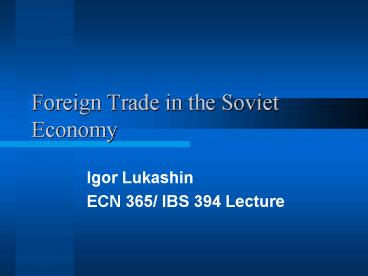Foreign Trade in the Soviet Economy - PowerPoint PPT Presentation
1 / 16
Title:
Foreign Trade in the Soviet Economy
Description:
Understand the limitations imposed by the structures and the rest of the Soviet economy ... Transferable (valuta) ruble. Little relation to the domestic ruble ... – PowerPoint PPT presentation
Number of Views:54
Avg rating:3.0/5.0
Title: Foreign Trade in the Soviet Economy
1
Foreign Trade in the Soviet Economy
- Igor Lukashin
- ECN 365/ IBS 394 Lecture
2
Todays Goals Foreign Trade Discussion
- Talk about theoretical benefits
- Describe the relevant Soviet structures
- Understand the limitations imposed by the
structures and the rest of the Soviet economy - Look at the composition of Soviet foreign trade
- Address the issue of foreign debt
3
Role of Foreign Trade in an Economy
- Welfare-enhancing (specialization)
- Efficiency-improving (international competition
stimulates domestic producers) - Access to goods/services not available on the
domestic market (advanced technology/peculiar
domestic costs)
4
Soviet Foreign Trade Structure
- Ministry of Foreign Trade (subordinate to
Gosplan) - Foreign Trade Organizations (FTOs)
- Sectoral/product organization
- Handle exports, imports or both
- Sometimes specialized by country/region (WHY???)
- AmTorg
- Financing through VneshTorgBank
5
Planning of Foreign Trade
- Avoiding heavy reliance
- Trade objectives
- import-export plan
- support materials and services for foreign
projects - balance of payments plan
- COMECON - Soviet bloc coordinating organization
- Detailed plans distribution by region, tasks of
each organization involved, schedule of deliveries
6
Planning of Foreign Trade Continued
- Accounting two types of currencies
- Convertible (hard) currency
- Transferable (valuta) ruble
- Little relation to the domestic ruble
- Integration into domestic plan
- no clear relationship to domestic prices
- FTO - intermediary
- Generated profits (surplus) for the State. How?
7
Trade Policies Trade Aversion
- Ideological rejection of basic economic laws
- Western markets viewed as chaotic
- Hostile capitalist encirclement
- Negative features of world market
- Inflation
- Unemployment gt attempt to insulate
- Low information flows FTO as information barrier
8
Internal Barriers to Foreign Trade
- Inability to understand compete effectively in
foreign markets - Lack of understanding??? Explain
- Exports limited gt imports limited
- Why?
- Export raw materials Import machinery (Table
9.1) - Ruble non-convertible currency
- Arbitrary Price-Setting Mechanisms no relation
to relative scarcities
9
Internal Barriers to Foreign Trade Continued
- No common scale to assess advantages of a trade
decision - Ignoring potential specialization gains
- Much of Trade in Barter
- Cumbersome Slow
- Foreign Trade Efficiency Coefficients
- Explain. 1 Bonus Point if within 30 sec
- Financial arrangement design
- Balanced trade against each partner
- Gold, convertible currency, arranged credits
10
Problems of Economic Integration
- 1949 COMECON - Soviet bloc trade
- Limited Integration (Table 9.2)
- Focus on own development and diversification
(strategic sufficiency) - COMECON - not a supranational power
- No integration of planning, no convertible
currency - Bank for International Cooperation
- Transferable ruble trade
- Difficult to see winners and losers
11
Trade with the West
- Significant increase after WWII
- 50b mid-1980s
- Exports Oil, Gas, Military Hardware
- Imports Agriculture (1/3), machinery, chemicals.
COCOM - LDC Trade 11 of Soviet FT
- Asia (India)
- Africa
- Latin America (Argentina)
12
Balance of payments issues the West
- Plan gt could balance convertible currency
receipts w/expenditures - Exports binding constraints on imports
- 1970s West Europe provided credit
- Debt Service problems
- Marketing difficulties
- Non-competitive products
- discrimination against soviet-made goods
13
Soviet Foreign Debt
- Imports
- Industrial goods services
- Grain fertilizer
- Receipts fall short of expenditures
- 12.5B -75 38B-mid-80s 48-1989
- Burden of debt
- Debt-service ratiopayments to total hard
currency earnings 10-25-23 - gross hard currency debt to hard currency
earnings 73-115
14
Direct Foreign Investment
- Tsarist economy - finance industrialization
- No direct investment in soviet economy
- no equity rights for foreigners
- complex counter-trade arrangements
- shares in productioin
- Unability to attract foreign capital - a major
weakness
15
Summary
- Foreign trade, specialization- important
- Soviet arrangement FTO
- Insulated domestic market
- Planned
- No convertible currency, no meaningful prices
- Barter
- Exports limiting imports
16
Group Assignment
- Remember the country you picked
- Identify beginning of transition
- Dates
- method (peaceful/revolt)
- players political parties, etc.
- Describe original economic reform package
- How did the prior developments (report 1)
affected the sequence (and problems) of reform
policies and their success?

